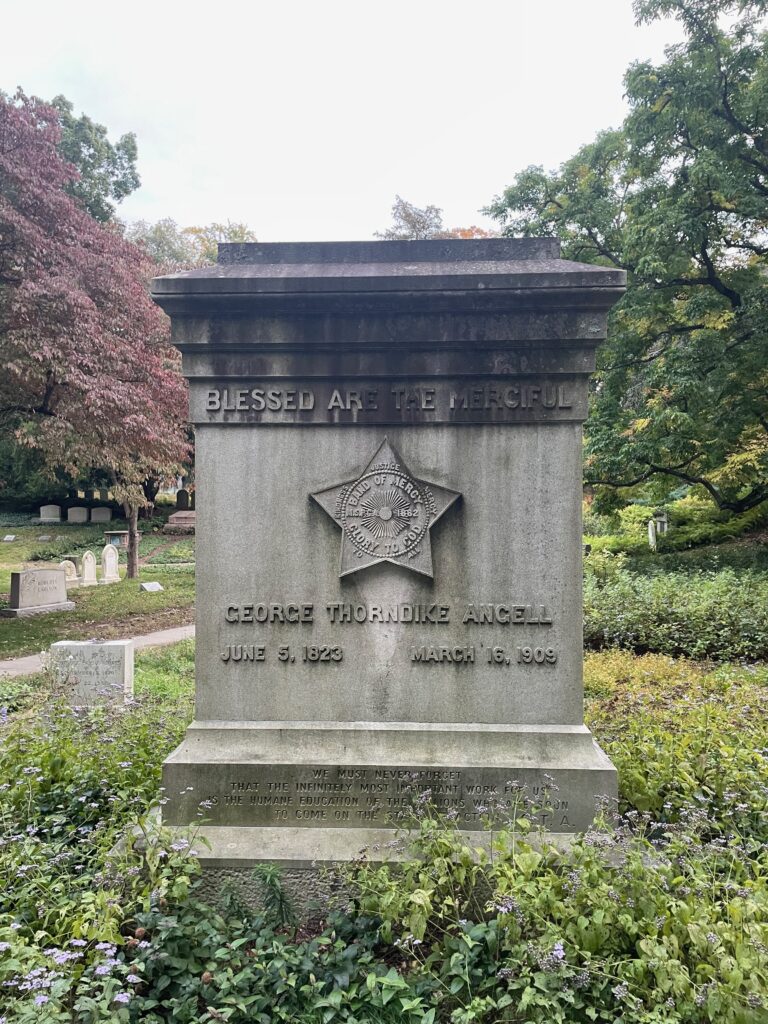Erik Visits an American Grave, Part 1,666
This is the grave of George Thorndike Angell.

Born in 1823 in Southbridge, Massachusetts, Angell grew up the son of a Baptist minister. The larger family had come from money but his father died when he was young. The family really had no mone of their own and so they became reliant on relatives, which kept them up in at least respectable poverty. In any case, this wasn’t real poverty, considering that Angell then went to Dartmouth and then Harvard Law. He was admitted to the bar in 1851 and practiced in Boston. He was involved in the abolitionist movement in Boston through the 1850s and of course was a strong supporter of the Union effort during the Civil War to defeat treason in defense of slavery. Now, this was the era of reform causes from northern elites, but Angell also took on one less well known today than abolitionism or women’s suffrage or temperance. He was deeply committed to animal rights.
In 1866, Angell read about a race between two riders over forty miles of rough road that led to the death of both horses. Angell was disgusted and determined to do something about it. Now, he wasn’t the only person who began to be interested in these issues. Henry Bergh in New York was a pioneer on this. Angell evidently already admired Bergh’s work. So he decided to follow the New Yorker. He wrote a letter to a Boston newspaper on how horrible this was. Among the letter’s readers was Emily Appleton, who was a wealthy animal-loving Bostonian. In 1868, Appleton funded and Angell founded and became president of the Massachusetts Society for the Prevention of Cruelty to Animals. Angell worked with a lot of other Brahmin elite types on this–John Quincy Adams II, Henry Saltonstall, William Gordon Weld, and Ralph Waldo Emerson were among them. They decided publicity was the way to go, so they created a magazine. Our Dumb Animals sounds like a terrible title, but the thing ran for 102 years, only shuttering in 1970. Of course, the use of “dumb” here was in the classic sense of being unable to speak rather than being stupid, though the latter usage as an insult has everything to do with making fun of the disabled. Basically, they wanted to speak for those who could not speak for themselves–the animals. This was a really critical move in the history of animal rights in America.
Our Dumb Animals did a lot of good work. It also played big time on Victorian sentimentality. All the animals were super faithful to humans, just wanting to please us. They were beautiful natural heroes. But they were owned by mean, cruel humans, probably Democrats. Still, someone, no doubt a Republican reformer type who would read this magazine, would come in and rescue them and establish the proper relationship between human and dog or horse or whatever. I wonder if they had many cat stories since cats don’t exactly follow Victorian rules of sentimentality and instead like to trip their owners or puke on the bed that you don’t discover until you get into bed, like what happened to me the other day. Thanks Smitty!
Although enforcement tended to be mixed at best, over the next few years, several states throughout the nation passed anti-cruelty statues based on Angell’s lobbying and work on the issue. In the 1870s, Angell wrote some books too. In 1872, he wrote Cattle Transportation in the United States, which I think was a treatise on just how poorly cows were treated as they went to market, which fair enough. He wrote another piece in 1874 called Protection of Animals, which is straightforward enough. He also wrote a memoir in 1882 titled Autobiographical Sketches and Personal Recollections, suggesting he needed an agent to work on the title. In 1881, he started a program called Bands of Mercy, which trained young people in “humane-education.” This thing actually became a big thing and by 1883, there were about 250,000 American children involved in this in one form of another. I imagine most of the involvement was pretty light, but with kids, just giving them this stuff can make a big difference in their attitudes for the rest of their lives.
Angell remained head of the Massachusetts Society for the Prevention of Cruelty to Animals for the rest of his life. That ended in 1909. He was 85 years old.
George Thorndike Angell is buried in Mount Auburn Cemetery, Cambridge, Massachusetts.
If you would like this series to visit other animal rights activists, you can donate to cover the required expenses here. Dian Fossey is in Volcanoes National Park, Rwanda, near the gorillas, so if you want to send me to Africa, I won’t object. Within the U.S., Roberta Kalechofsky is in Danvers, Massachusetts and Bob Barker is in Hollywood. And remember, get your pets spayed or neutered. Previous posts in this series are archived here and here.


